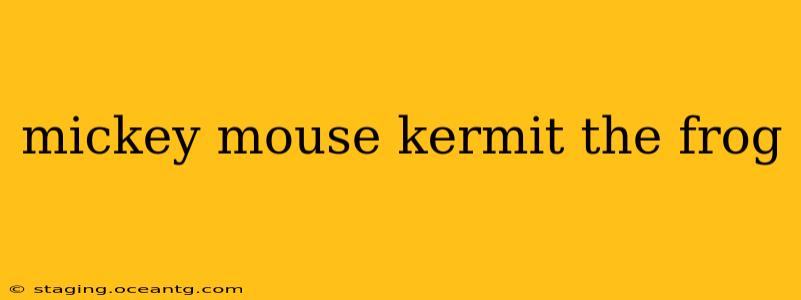Mickey Mouse and Kermit the Frog. Two names synonymous with childhood, animation, and the enduring power of entertainment. While seemingly disparate at first glance – one a mischievous mouse from the dawn of animation, the other a wise-cracking frog from a felt-filled swamp – these characters share a surprising amount of common ground. Both represent enduring legacies, cultural touchstones that have transcended generations and continue to resonate with audiences worldwide. This exploration delves into their individual histories, comparing and contrasting their impact on entertainment and popular culture.
What makes Mickey Mouse and Kermit the Frog so different?
Despite their shared success, Mickey and Kermit occupy distinct niches within the entertainment landscape. Mickey Mouse, born in the black-and-white era of animation, embodies a classic, almost archetypal innocence. He's the optimistic everyman, always getting into scrapes but emerging victorious through ingenuity and a little help from his friends. His evolution from a somewhat mischievous character in early shorts to a more wholesome icon reflects changing societal values and the maturing nature of animation itself. His visual design is simple yet instantly recognizable, a testament to the power of effective character design.
Kermit, on the other hand, debuted in a very different world. He’s the pragmatic voice of reason amidst the often chaotic Muppet world. His appeal lies in his relatable cynicism and his ability to navigate the absurdities of his surroundings with a dry wit and a surprisingly resilient spirit. He's less of a pure-hearted hero and more of a perpetually exasperated leader, making him deeply relatable to adult audiences as well as children. The Muppets, as a whole, embrace a more improvisational, character-driven style, contrasting with the structured narratives often associated with early Disney cartoons.
What are the similarities between Mickey Mouse and Kermit the Frog?
Beyond their undeniable success, Mickey and Kermit share several key similarities. Both characters are versatile performers, adaptable to various storytelling styles and media. Mickey has starred in everything from classic shorts to feature films, while Kermit has hosted television shows, appeared in movies, and even ventured into the world of Broadway. This adaptability is a crucial component of their lasting appeal.
Moreover, both characters are master puppeteers, albeit in different ways. Mickey, initially brought to life through the artistry of animators, has always possessed a subtle expressiveness that makes him convincingly emotive. Kermit, quite literally a puppet, benefits from the skill and charisma of his puppeteer (Jim Henson, initially, and later others), whose talents breathed life into the felt frog.
Their staying power hinges on their ability to connect with audiences across generations. Both characters remain relevant not only because of their timeless appeal but also due to the constant reinterpretation and adaptation to new media and trends. They represent more than just characters; they’re symbols of optimism, resilience, and the enduring magic of storytelling.
How are Mickey Mouse and Kermit the Frog different from other cartoon characters?
Mickey and Kermit stand apart from many other cartoon characters due to their longevity and adaptability. Many beloved characters have had limited runs or have seen their popularity fade over time. Mickey and Kermit, however, have consistently reinvented themselves, staying relevant to changing audiences. This speaks to the quality of their initial designs, the creativity of their creators, and their enduring appeal. Their ability to resonate across different cultural contexts is also noteworthy. They're not just American icons; they're global phenomena.
Why are Mickey Mouse and Kermit the Frog so popular?
The enduring popularity of both characters stems from their distinct personalities and the clever storytelling that surrounds them. Mickey's optimism and constant struggle against adversity provides audiences with relatable scenarios, while Kermit's wry commentary on the chaos around him is both humorous and comforting. Furthermore, the supporting characters in both universes add depth and complexity to their stories, creating rich and memorable worlds. It's the combination of compelling characters, imaginative stories, and consistent quality that has cemented their places in pop culture history. They've also expertly used different media to maintain their relevance, moving beyond their initial platforms to conquer television, film, theme parks, merchandise, and more.
Conclusion: A Legacy of Laughter and Imagination
Mickey Mouse and Kermit the Frog represent two pillars of animation and puppetry, each leaving an indelible mark on the entertainment world. Their journeys, though distinct, share a common thread: the ability to connect with audiences through humor, heart, and unforgettable storytelling. They stand as testaments to the enduring power of character design, creative innovation, and the timeless appeal of laughter and imagination. They continue to inspire new generations, ensuring that their legacies will live on for years to come.
